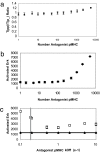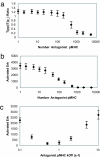Sensitivity of T cells to antigen and antagonism emerges from differential regulation of the same molecular signaling module
- PMID: 17360359
- PMCID: PMC1838481
- DOI: 10.1073/pnas.0611482104
Sensitivity of T cells to antigen and antagonism emerges from differential regulation of the same molecular signaling module
Abstract
Activation of T helper cells is necessary for the adaptive immune response to pathogens, and spurious activation can result in organ-specific autoimmunity (e.g., multiple sclerosis). T cell activation is initiated by membrane-proximal signaling that is predicated on the binding of the T cell receptor expressed on the T cell surface to peptide major histocompatibility complex (pMHC) molecules presented on the surface of antigen-presenting cells. These signaling processes regulate diverse outcomes, such as the ability of T cells to discriminate sensitively between stimulatory pMHC molecules and those that are characteristic of "self," and the phenomenon of antagonism (wherein the presence of certain pMHC molecules impairs T cell receptor signaling). We describe a molecular model for membrane-proximal signaling in T cells from which these disparate observations emerge as two sides of the same coin. This development of a unified mechanism that is consistent with diverse data would not have been possible without explicit consideration of the stochastic nature of the pertinent biochemical events. Our studies also reveal that certain previously proposed concepts are not dueling ideas but rather are different stimuli-dependent manifestations of a unified molecular model for membrane-proximal signaling. This model may provide a conceptual framework for further investigations of early events that regulate T cell activation in response to self and foreign antigens and for the development of intervention protocols to inhibit aberrant signaling.
Conflict of interest statement
The authors declare no conflict of interest.
Figures




Similar articles
-
Modeling T cell antigen discrimination based on feedback control of digital ERK responses.PLoS Biol. 2005 Nov;3(11):e356. doi: 10.1371/journal.pbio.0030356. Epub 2005 Oct 25. PLoS Biol. 2005. PMID: 16231973 Free PMC article.
-
CD4 enhances T cell sensitivity to antigen by coordinating Lck accumulation at the immunological synapse.Nat Immunol. 2004 Aug;5(8):791-9. doi: 10.1038/ni1095. Epub 2004 Jul 11. Nat Immunol. 2004. PMID: 15247914
-
Early T cell receptor signals globally modulate ligand:receptor affinities during antigen discrimination.Proc Natl Acad Sci U S A. 2017 Nov 14;114(46):12190-12195. doi: 10.1073/pnas.1613140114. Epub 2017 Oct 30. Proc Natl Acad Sci U S A. 2017. PMID: 29087297 Free PMC article.
-
Comparative study of the role of professional versus semiprofessional or nonprofessional antigen presenting cells in the rejection of vascularized organ allografts.Transpl Immunol. 1995 Dec;3(4):273-89. doi: 10.1016/0966-3274(95)80013-1. Transpl Immunol. 1995. PMID: 8665146 Review.
-
The dynamics of T cell receptor signaling: complex orchestration and the key roles of tempo and cooperation.Annu Rev Immunol. 1999;17:467-522. doi: 10.1146/annurev.immunol.17.1.467. Annu Rev Immunol. 1999. PMID: 10358766 Review.
Cited by
-
Computational investigations into the origins of short-term biochemical memory in T cell activation.PLoS One. 2007 Jul 18;2(7):e627. doi: 10.1371/journal.pone.0000627. PLoS One. 2007. PMID: 17637843 Free PMC article.
-
SRC family kinases and receptors: analysis of three activation mechanisms by dynamic systems modeling.Biophys J. 2008 Mar 15;94(6):1995-2006. doi: 10.1529/biophysj.107.115022. Epub 2007 Nov 30. Biophys J. 2008. PMID: 18055537 Free PMC article.
-
Kinetic proofreading and the search for nonself-peptides.Self Nonself. 2011 Jan;2(1):1-3. doi: 10.4161/self.2.1.15362. Epub 2011 Jan 1. Self Nonself. 2011. PMID: 21776328 Free PMC article.
-
Simple biochemical networks allow accurate sensing of multiple ligands with a single receptor.PLoS Comput Biol. 2017 Apr 14;13(4):e1005490. doi: 10.1371/journal.pcbi.1005490. eCollection 2017 Apr. PLoS Comput Biol. 2017. PMID: 28410433 Free PMC article.
-
Receptor signaling clusters in the immune synapse.Annu Rev Biophys. 2012;41:543-56. doi: 10.1146/annurev-biophys-042910-155238. Epub 2012 Feb 23. Annu Rev Biophys. 2012. PMID: 22404679 Free PMC article. Review.
References
-
- Irvine DJ, Purbhoo MA, Krogsgaard M, Davis MM. Nature. 2002;419:845–849. - PubMed
-
- Purbhoo MA, Irvine DJ, Huppa JB, Davis MM. Nat Immunol. 2004;5:524–530. - PubMed
-
- Krogsgaard M, Li QJ, Sumen C, Huppa JB, Huse M, Davis MM. Nature. 2005;434:238–243. - PubMed
-
- Grakoui A, Bromley SK, Sumen C, Davis MM, Shaw AS, Allen PM, Dustin ML. Science. 1999;285:221–227. - PubMed
-
- Monks CR, Freiberg BA, Kupfer H, Sciaky N, Kupfer A. Nature. 1998;395:82–86. - PubMed
Publication types
MeSH terms
Substances
Grants and funding
LinkOut - more resources
Full Text Sources
Other Literature Sources

